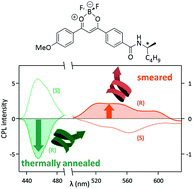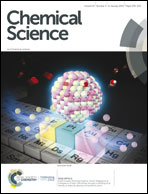Mechano-responsive circularly polarized luminescence of organic solid-state chiral emitters†
Abstract
Two difluoro-boron β-diketonate complexes bearing chiral amido groups have been synthesized. Their mechano-responsive luminescence and chiroptical properties have been investigated in the solid state. Both compounds display a bright blue-green emission and a significant circularly polarized luminescence (CPL) signal in the crystalline state, with |glum| values as high as 2.2–2.4 × 10−2. A bathochromic shift in emission, together with a decrease of |glum| values to c.a. 3 × 10−3, is induced upon application of a shearing stress. For the DFB-Hex-amide compound, interestingly, sign inversion of the anisotropy factor glum is observed under mechanical stimulation (“mechano-CPL effect”), which can be rationalized by a switching between monomer and excimer emission.



 Please wait while we load your content...
Please wait while we load your content...